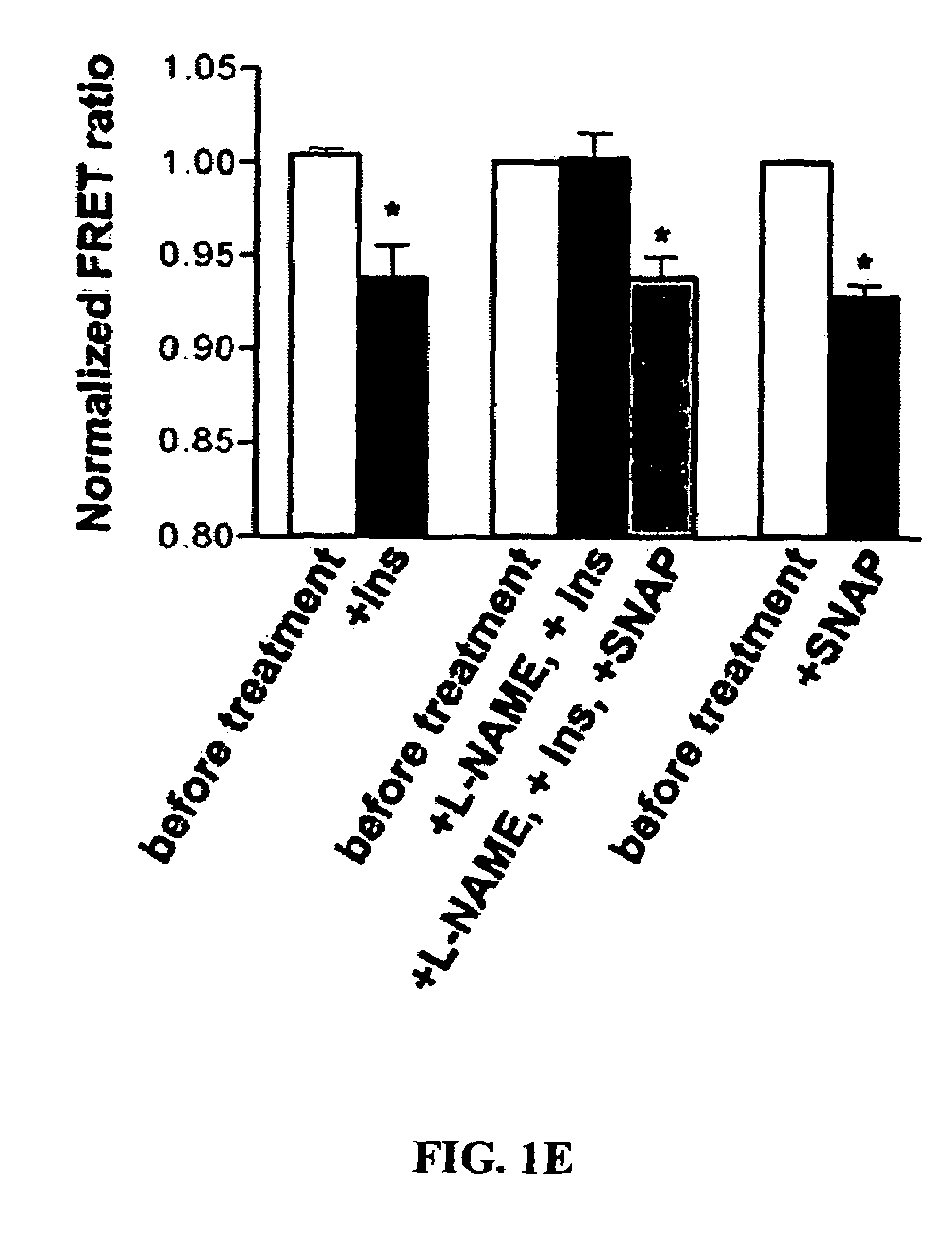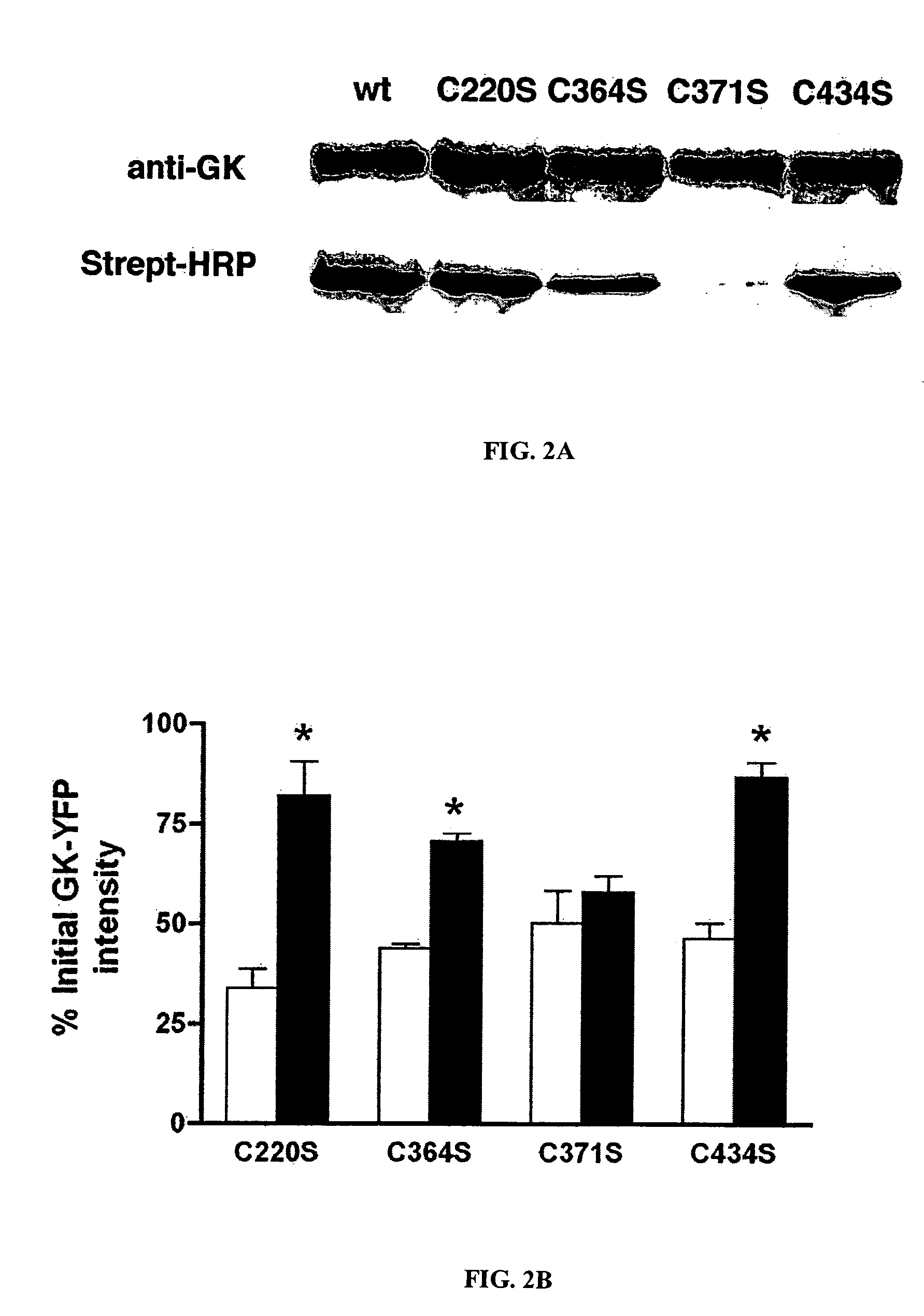Methods of screening for a candidate modulator of glucokinase
a technology of glucokinase and modulator, applied in the field of screening for modulators of glucokinase, can solve the problems of mellitus (niddm, 7% of the world population) and other glycemic disorders
- Summary
- Abstract
- Description
- Claims
- Application Information
AI Technical Summary
Benefits of technology
Problems solved by technology
Method used
Image
Examples
example 1
Materials and Methods
[0130]Cell culture. βTC3 cells were cultured as described (Rizzo et al., 2002) and were transferred to media containing 1 g / L glucose overnight prior to observation. 3 h prior to experimentation, cells were washed 4 times and incubated with BMHH buffer (125 mM NaCl, 5.7 mM KCl, 2.5 mM CaCl2, 1.2 mM MgCl2, 10 mM Hepes, pH 7.4) containing 0.1% BSA. For FRAP, CFP-GK-YFP FRET, and nitrosylation experiments, DNA plasmids containing GK-YFP constructs, proinsulin-CFP, or CFP-GK-YFP were introduced by electroporation prior to seeding as previously described (Rizzo et al., 2002). For studies requiring co-transfection, plasmid DNA encoding the indicated constructs were transfected using either a ratio of (2 μg nNOS-CFP:1 μg GK-YFP:6 μl FUGENE (Roche Applied Science)) or of (1 μg nNOS-CFP-nuc:2 μg GK-YFP:6 μl FUGENE). Transfection was for 4 h in serum-free media, followed by replacement with low-glucose media. Observation took place the following day.
[0131]Generation of co...
example 2
Results and Discussion
[0136]To assess the role of NOS in the regulation of GK by insulin, the inventors examined whether insulin could stimulate NO production in β cells. βTC3 cells were loaded with 4-amino-5-methylamino-2′,7′-difluorofluorescein diacetate (DAF-FM) (Kojima et al., 1999), an indicator dye whose fluorescence increases upon reaction with NO. A rapid increase in the fluorescence of DAF-FM was observed within minutes in insulin-treated cells as compared to untreated cells (FIG. 1A). This indicates that insulin treatment results in NO production on a time-scale consistent with regulation of GK (Rizzo et al., 2002). The inventors also examined the role of NOS activation in the regulation of GK association with secretory granules. Association of GK with secretory granules was analyzed in cells expressing a YFP labeled GK (GK-YFP) and a CFP targeted to insulin granules by insertion into a proinsulin cDNA (Watkins et al., 2002; Rizzo et al., 2002) (FIG. 1B). Association of GK...
PUM
| Property | Measurement | Unit |
|---|---|---|
| pH | aaaaa | aaaaa |
| temperature | aaaaa | aaaaa |
| pH | aaaaa | aaaaa |
Abstract
Description
Claims
Application Information
 Login to View More
Login to View More - R&D
- Intellectual Property
- Life Sciences
- Materials
- Tech Scout
- Unparalleled Data Quality
- Higher Quality Content
- 60% Fewer Hallucinations
Browse by: Latest US Patents, China's latest patents, Technical Efficacy Thesaurus, Application Domain, Technology Topic, Popular Technical Reports.
© 2025 PatSnap. All rights reserved.Legal|Privacy policy|Modern Slavery Act Transparency Statement|Sitemap|About US| Contact US: help@patsnap.com



